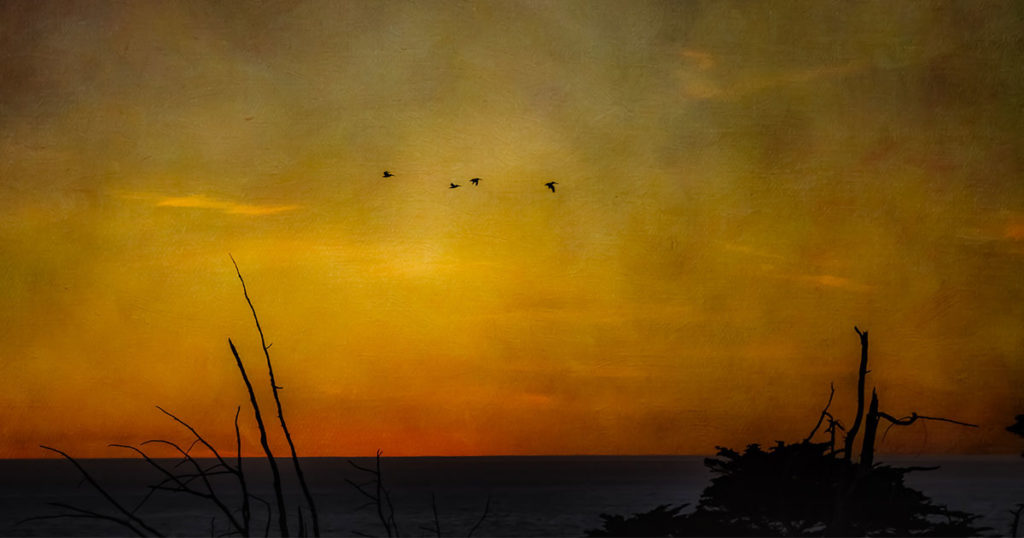Witness to an Unfolding Disaster
On this 50th Earth Day, a painter meditates on the changing relationship between her art and our imperiled planet

A memory: April 22, 1970. New York City. I am 11, skipping home from school in my navy blue uniform, knee socks, and Thom McAns. I stop in Union Square to check out the celebration of the first Earth Day and spot a stainless-steel tanker truck. It’s filled with spring water from upstate. I get in line for a sample served in a small, cone-shaped Dixie cup. I remember it as the best water I had ever tasted, and I can still see the park on that warm afternoon, when shafts of sunlight streamed through the vaulted ceiling of the elms, anointing the hustlers and junkies on the benches.
Fifty years later. Marin County, California. Also a warm afternoon. I am sitting under the Japanese maple in my garden, wishing my neighbor’s leaf blower would stop so I can resume listening to the thrum of the dragonfly maneuvering overhead.
I am a landscape painter. Nature has always been my main source of inspiration and my refuge of first resort. But now that natural disaster follows natural disaster with hardly a beat in between, I find myself scribbling notes like “Landmass, one word. Land mass two words. Mass as in requiem.” I wonder, am I painting requiems for nature as I have known it? Am I painting my dread of the future hurtling our way because of climate change? For me, land and beauty are fused; when I am thinking about one, I am thinking about the other. I still paint the beauty I see, but lately the paintings have been going rogue, like the weather. Weird colors and touches of menace are turning up on the canvas.
I sometimes walk to the Pacific at dusk. It’s a pleasure, of course, and with no conscious effort, I absorb new images and ideas for painting. I recently watched a contrail from a jet heading deeper and deeper into a pale violet sky. I stared at the white streak and wondered when it will find its way into one of my paintings. That evening I also took a long look at the sagebrush and manzanita spreading across the valley and up the slope of the headlands. Scrub like this easily catches fire, and as I looked on, it occurred to me that I was searching for escape routes. The realization landed like a blow. This spot, which has always been one of my sanctuaries, now feels dangerous.
As I tried to put this paradox on paper in my studio, I was torn between registering the evening’s beauty and depicting my alarm. Hoping to capture the disturbance I felt on that walk, I start with the middle ground, painting a pond that reflects the headlands. With dry brush, I scatter rocks in the foreground and embed them in a thicket of scrub. I see that, without conscious effort, I’ve created an impenetrable barrier between me and the pond. Have I just painted my fear of getting trapped? With a rag I strip away all but a ghost of the thicket. Then, in my mind’s eye, I see the wind picking up and the clouds marching across the sky. The valley starts to feel like a tinderbox. I add red marks without knowing if they’re tiny fires about to be fanned by the wind or beacons marking an exit. Not too long ago, I would have painted the serenity of a still pond at twilight. I reach for my notebook and write “Code Red. Engulfed.” Beauty will not suffice. I wreck it with a streak of smoky umber.
In the garden, I notice that the blossoming hellebores are flopped over. They need water. So does the lawn. For me, the weather has been perfect—sunny with temperatures in the 70s day after day. But I have to reckon with the fact that all signs point to another drought. And more fires.
My studio used to feel like a haven. Now it sometimes makes me feel guilty, because my oil paints generate toxic waste. I love these paints; when I’m using them I feel physically attached to the history of art. But given what’s happening to the Earth, I have to cut back on the solvents I use to clean my brushes. I am shifting from oil-based paints to water-based paints, and I am thinking about paint the way I think about produce: Is it “organic?” Where’s it from? How much do I really need?
Making the switch feels imperative, but it also makes me nostalgic for the days when I shopped for oil paints at the same New York stores as de Kooning, Motherwell, and Frankenthaler. Those stores, now gone, were my palaces, places where I felt inspired and nourished by the painters who had come before me. The pleasures were sensual: I could test the responsiveness of a brush, get to know the tooth of various kinds of paper, see the brilliance of cobalt blue, and sniff everything, including rubber cement. Now my paint comes by UPS. There’s no romance, no sense of connection with painters of the past.
For me, the beauty of the natural world is not something “out there.” I have been taking it in every day, for decades, and as a landscape artist, I’m driven to transform the beauty I see into paintings. But I also feel compelled to do work that confronts the devastation of the natural world. Some days I paint beauty. Some days I wreck the beauty I just painted. On this year’s Earth Day, I plan to sift through the ruins, looking hard in hopes of finding a few green shoots. And I will keep an ear out for the dragonflies.

